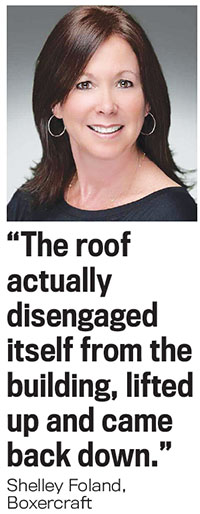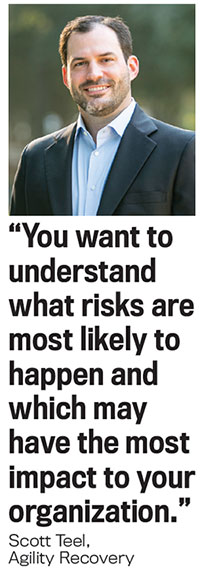Awards May 11, 2018
How To Create A Business Continuity Plan
After 2017 decimated communities with hurricanes, fires and floods, having a business continuity plan is more important than ever. Here’s advice for creating one that works.
Shelley Foland, the CEO of Boxercraft (asi/41325), was visiting a customer on November 30, 2016, when she heard the news. A tornado had ripped through Mableton, GA, touching down on Discovery Boulevard, home of the Boxercraft facility. Terrifyingly, she heard through texts from friends and colleagues checking to make sure she was alright in the storm. She was, but the building didn’t fare quite as well.
Bill Korowitz was equally unprepared when fire destroyed the Pittsburgh-based Pro Towels (asi/79750) facility that he once owned. It was a Saturday and he was at home with his family, three hours away. By the time he arrived, the building was completely destroyed.
Karen Sharp, president of Houston-based Proforma Impact Promotions (asi/300094), was a little more prepared for the disaster she faced – although the impact was similarly devastating. Sharp’s life and company were in the path of a Hurricane Harvey-induced flood.
Finally, David Tate, president of Memphis-based Signet Inc. (asi/326636), had to deal with an ice storm power outage that lasted 10 days, which in business is, of course, an eternity.
Aside from facing business interruptions out of their control, these four leaders had something else in common as well: None of them had a formal business continuity plan in place to rely on when tragedy struck.
Assessing the Damage
The day after the tornado, Foland went to see just how bad things were. Let’s just say they weren’t good. “The roof actually disengaged itself from the building, lifted up and came back down,” Foland says.
 Two screen-printing presses had major water damage, thanks to 125 feet of compromised roofing, leading to about two and a half weeks of lost production time. The presses could be saved though – a restoration company came in that same night to tear them down and dry them out. Foland says only one part ended up needing full replacement. As for the roof, the damaged part needed to be replaced, and the resulting flooding in the distribution center was remediated with lots of dehumidifiers. Luckily for Boxercraft, none of the finished goods inventory sustained damage, and customers stuck by the company throughout the disaster. They knew it was out of Boxercraft’s control.
Two screen-printing presses had major water damage, thanks to 125 feet of compromised roofing, leading to about two and a half weeks of lost production time. The presses could be saved though – a restoration company came in that same night to tear them down and dry them out. Foland says only one part ended up needing full replacement. As for the roof, the damaged part needed to be replaced, and the resulting flooding in the distribution center was remediated with lots of dehumidifiers. Luckily for Boxercraft, none of the finished goods inventory sustained damage, and customers stuck by the company throughout the disaster. They knew it was out of Boxercraft’s control.
Things were tough in a different way for Sharp. She’s a one-woman show at her office (though she does have an assistant and co-owners), and she had recently been diagnosed with cancer when the flooding hit. In essence, her firm suffered both from a natural disaster and a health disaster. According to Sharp, after the flood and her treatments – plus relocation, as she works out of her home – business slipped down to about 70% of what it normally averages. But thanks to incredibly solid business relationships with understanding customers and co-owners who were willing to pick up some slack, things weren’t any worse than they needed to be.
When Korowitz, who now is the CEO of The Magnet Group (asi/68507), returned to work after the fire, part of the process to recovery was assessing exactly how the blaze had occurred. His entire team learned a valuable lesson: Lint is incredibly flammable.
“In the building, someone added on to the managerial offices and they forgot to close a piece of the roof,” Korowitz says. “There was a four-by-four piece that was open, and lint filtered down there year after year, eventually reaching up to the electrical outlet in the wall.”
It turns out that one employee, before he left for work one day, pulled out a power strip so no electricity would run through there over the weekend. “When he pulled the plug, it sparked and hit that lint,” Korowitz says. “The lint was like gasoline. It just went up, whoosh. His office was by the door so he pulled the plug, walked out the door, locked it, got in his car, and by the time he got a mile away the building was completely on fire.”
The entire decoration facility was destroyed. While they waited for the site to be rebuilt (it took about 90 days), business interruption insurance kicked in – and so did competitors. They knew Pro Towels had outstanding orders and offered to help process them with similar products. Still, though, the company suffered a sales hit of about $5 million and spent about $500,000 rebuilding. Paying employees always came first, and Korowitz happily remembers that thanks to the insurance, Pro Towels was still able to make its expected profits, even with the $5 million hit, and no employee missed a paycheck.
Tate’s business suffered two major power outages, one in 1994 from an ice storm and another in 2004 thanks to Hurricane Elvis. But it was the 1994 outage that was the worst. It lasted 10 days, and it was back before technology was so ubiquitous – so not everyone had cellphones, and much of the recovery timeline was at the mercy of the city of Memphis. Both power lines and phone lines were down, and there was nothing the Signet team could do about it because they didn’t have a backup generator. Tree limbs fell across the city, tearing siding off the building the team worked from and stopping many employees from even getting out of their driveways.
By 2004, the company had enough experience with this type of disaster to immediately borrow a generator and get operations back online; but because the city itself was still down, employees were having trouble at their own homes. They couldn’t shower, they didn’t have electricity, and it amped up stress levels for everyone. Tate remembers the saving grace with both situations was that the entire city was down along with the business, so impact was minimized.
Making Changes
Since the disasters, these businesses have worked to ensure their recovery after any future incidents would be smoother. Tate has made some of the most significant progress. Now the company has a full disaster plan in effect, completely informed by the past two major power outages, that runs through a sequential list of activities and who’s responsible for that task.
 “The lessons of 1994 and 2004 brought us to where we are today, where I just don’t think we’ll have an issue unless a tornado takes the building to the ground,” Tate says.
“The lessons of 1994 and 2004 brought us to where we are today, where I just don’t think we’ll have an issue unless a tornado takes the building to the ground,” Tate says.
Every piece of Signet’s business is backed up in multiple locations, with servers in different cities. The distributor has a generator that’s tested every month to make sure it’s in optimal condition, and also has a contract with a company that will keep the generator fueled as necessary during a disaster. The promo firm has also implemented a text and email blast service to employees in case something goes wrong, so they can be updated. Even the internet service has redundancy. The comprehensive disaster plan the company leaders formed is tested in real-time every year to see if updates are needed – and that plan is backed up in another part of town.
Still, though, Tate says during a disaster he would do one thing different from before, even with everything currently in place: he’d rent hotel rooms so employees can have some air conditioning and get to shower.
“We took care of business, but my jaw was dropping because after about the eighth day of the power outage, they were at each other’s throats here,” he says. “It was like, I can’t believe this is my company, but it was just the circumstances. That’s what I would do over – find ways to deal with personal comfort and address the challenges and stresses employees were having at home.”
At Boxercraft, the executive team took similar steps to Tate by creating an emergency response committee with representatives from all areas of the business. The company has purchased emergency equipment like flashlights and radios, and has updated evacuation routes. They also have emergency drills, conducted once a quarter.
Korowitz took the experience he went through and transformed it into a disaster plan for The Magnet Group. He pays it forward to help competitors whenever necessary, like they did for him. All the company information is backed up, and he’s extra diligent when checking sprinkler systems in the building.
“As expensive as it is, you have to do that stuff because shortcutting it could be catastrophic,” he says.
For Sharp, though, the disaster plan is still all in her head. As a one-stop shop with no inventory, she focuses mainly on record and data preservation, keeping it all in the cloud to access in case her computer falls victim to a disaster.
“If you have employees, staff and other sales reps, then I do think it’s really important to have a good disaster plan because those people’s livelihoods are dependent upon that,” Sharp says. “So, if something happens to you as an owner, they know exactly what to do. But if something happens to me as an owner, there’s not any ‘they.’ There’s no ‘them’ to put anything into place.”
Creating an Official Plan
Scott Teel, VP of organizational development at Agility Recovery, a Denver-based consultancy, notes there’s a pretty standard format to follow when developing a continuity plan – and every company, no matter what size, should have one in place.
 The first step is to examine the fundamentals of your business. He suggests taking a look at what you have and what’s most important were a disaster to occur, and do a risk assessment.
The first step is to examine the fundamentals of your business. He suggests taking a look at what you have and what’s most important were a disaster to occur, and do a risk assessment.
“You want to understand what risks are most likely to happen and which may have the most impact to your organization,” Teel says. “That will essentially help you prioritize what it is you actually spend your time, energy, effort and money preventing, mitigating or recovering from.”
For a small company, that doesn’t have to take much time. Hook up with an insurance professional who’s familiar with the promotional products industry and might have insight into how your particular business works. After a quick conversation, a good agent should be able to give you a short list of the main threats you need to be prepared for.
Next, tackle a business impact analysis. This will essentially take the information you have on potential risks and combine that with the critical functions of your business so you can understand exactly what needs protecting and how to protect it.
“It’s one of those terms that sounds scary, but really all you’re doing is saying well, if the power goes out, which is highly likely from a number of different threats, how does that affect my business?” Teel says. “And what are the most important parts of my business I have to really protect from that particular threat? Then you go down that list again, using the prioritized list of risks you already identified.”
Teel thinks it’s important to remember not all disasters come from natural sources. Like the power outages that affected Signet and the fire Korowitz faced, isolated incidents can wreak havoc on a business as well – things like downed phone lines, burst pipes or even car accidents. In the promotional products industry, there can be an extra layer of chaos, because suppliers and distributors are scattered throughout the country – burst pipes at your supplier’s facility in Wisconsin can have a significant effect on your business in Texas. Make sure to plan for those types of issues as well.
“The bottom line is to look at the critical business functions you’re trying to protect and what elements are needed in order to facilitate that function, like power and connectivity, telephones, office space and computer hardware, and protect and have backups for those items,” Teel says. “Don’t necessarily worry about having different plans for a variety of incidents. Instead, have your strategies built around restoring the most critical functions of your business regardless of what the interruption may be.”
Communicating with staff and customers is one of the best things you can do during a disaster, Teel believes. Make sure your employees don’t all rely on one cellphone carrier in case those towers all go out, and get active on social media to keep customers up-to-date on your recovery progress. Most importantly, though, test your recovery plan on a regular basis.
“A football team doesn’t write their playbook, send it out to all of the teammates and then just show up for the first game, right?” Teel says. “They practice and practice and practice.”
